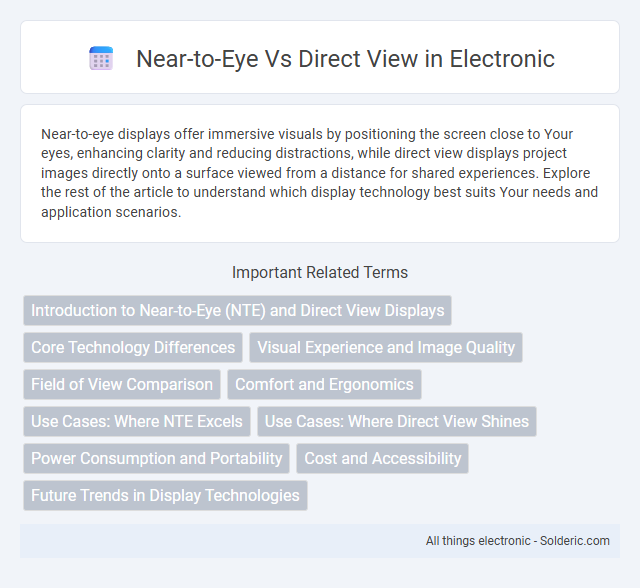Near-to-eye displays offer immersive visuals by positioning the screen close to Your eyes, enhancing clarity and reducing distractions, while direct view displays project images directly onto a surface viewed from a distance for shared experiences. Explore the rest of the article to understand which display technology best suits Your needs and application scenarios.
Comparison Table
| Feature | Near-to-Eye (NTE) | Direct View |
|---|---|---|
| Display Position | Close to the eye using optics | Directly in front, no optics required |
| Field of View (FOV) | Limited, typically narrow | Wide and naturally immersive |
| Use Cases | AR glasses, VR headsets, HUDs | Monitors, TVs, projectors |
| Portability | High, compact and wearable | Low, usually stationary devices |
| Visual Immersion | High, immersive experience | Moderate, depends on screen size |
| Eye Strain | Can cause fatigue due to proximity | Less strain, natural viewing distance |
| Power Consumption | Generally higher due to optics & display | Typically lower, simpler displays |
| Cost | Higher, involves advanced optics | Lower, standard display technology |
Introduction to Near-to-Eye (NTE) and Direct View Displays
Near-to-Eye (NTE) displays position visual content close to your eyes, leveraging optics to project images directly onto the retina or within a small viewing area, enhancing immersion and reducing external distractions. Direct View displays present images on surfaces or screens visible at a distance, prioritizing wide field of view and brighter output over personal proximity. Understanding the fundamental differences in optics and user experience is essential when selecting between NTE and Direct View technologies in augmented reality or wearable displays.
Core Technology Differences
Near-to-Eye displays project images directly in front of your eyes using waveguides or microLEDs for augmented reality experiences. Direct View technology relies on self-emitting pixels like OLED or MicroLED, allowing you to see images on large, flat surfaces without intermediary optics. Core technology differences include how light is delivered and perceived: Near-to-Eye devices guide light through optical elements, while Direct View screens emit light visible to the naked eye.
Visual Experience and Image Quality
Near-to-eye (NTE) displays offer immersive visual experiences with high pixel density and close proximity to the eye, resulting in enhanced image sharpness and detail. Direct view displays typically provide broader field-of-view and natural perspective but may suffer from lower pixel density and decreased image clarity at close distances. The choice between NTE and direct view balances image quality with viewing comfort, affecting applications like augmented reality and virtual reality.
Field of View Comparison
Near-to-Eye (NTE) displays typically offer a wider field of view (FOV) compared to direct view displays due to their close proximity to the eye, often ranging from 40 to 90 degrees. Direct view displays, such as smartphones and tablets, generally have a limited FOV constrained by screen size and viewing distance, usually around 30 to 50 degrees. Enhanced FOV in NTE technology improves immersive experiences in augmented and virtual reality applications by providing a broader visual context.
Comfort and Ergonomics
Near-to-Eye displays offer superior comfort and ergonomics by reducing the need for extensive head and eye movement, allowing users to maintain a natural posture during extended use. Their lightweight design minimizes neck strain and supports prolonged wear compared to traditional direct view screens. In contrast, direct view displays often require users to focus on larger screens at varying distances, which can cause eye fatigue and less ergonomic positioning over time.
Use Cases: Where NTE Excels
Near-to-Eye (NTE) displays excel in augmented reality applications like industrial maintenance, medical procedures, and immersive training sessions by providing hands-free access to critical data. They enhance user safety and efficiency in environments where real-world interaction is vital, such as manufacturing floors or surgical suites. Your experience benefits from real-time, context-aware information without obstructing your natural field of vision.
Use Cases: Where Direct View Shines
Direct view displays excel in applications requiring real-time, high-fidelity visuals such as surgical procedures, industrial inspections, and augmented reality gaming. Their ability to project large, immersive images with minimal latency enhances situational awareness and precision in fields like aviation and remote drone piloting. The ergonomic design supports prolonged use without eye strain, making them ideal for extended monitoring and interactive training environments.
Power Consumption and Portability
Near-to-Eye (NTE) displays consume significantly less power due to their compact optics and efficient light source integration, making them ideal for battery-dependent wearable devices. Direct View displays tend to have higher power consumption driven by larger screen sizes and more lumens required for visibility, reducing their suitability for portable applications. Portability favors NTE systems because their lightweight, compact design enables seamless integration into headsets or smart glasses, whereas Direct View screens are bulkier and less convenient for mobile use.
Cost and Accessibility
Near-to-Eye (NTE) displays generally offer lower costs and greater accessibility due to their compact design and reliance on common electronic components, making them suitable for consumer electronics, augmented reality headsets, and wearable devices. In contrast, Direct View (DV) displays, such as large LED or OLED screens, tend to have higher manufacturing and maintenance expenses, limiting accessibility primarily to commercial or professional applications. The affordability and widespread availability of NTE technology drive its adoption in immersive experiences, while DV remains favored for high-resolution, large-scale visual presentations.
Future Trends in Display Technologies
Near-to-eye (NTE) displays, such as augmented reality (AR) glasses and virtual reality (VR) headsets, are rapidly advancing with improvements in microdisplays and waveguide optics to offer higher resolution and wider fields of view. Direct view displays, including OLED and microLED screens, continue to evolve for enhanced brightness, contrast, and flexibility in applications like smartphones, TVs, and digital signage. Future trends indicate a convergence where NTE displays integrate more seamless and immersive experiences while direct view technologies push toward foldable, transparent, and self-emissive displays for versatile use cases.
Near-to-Eye vs Direct View Infographic

 solderic.com
solderic.com